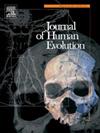Locomotor adaptation in the hominoid clavicle through ontogeny
IF 3.1
1区 地球科学
Q1 ANTHROPOLOGY
引用次数: 0
Abstract
Reconstructions of the locomotor behavior of early hominins have been hindered by our incomplete understanding of the form-function relationship in the extant hominoid shoulder. Although extensive research has highlighted the role of the highly mobile shoulder in supporting the locomotor diversity and versatility observed in hominoids, the contribution of the clavicle and its morphological diversity to shoulder function remains significantly underexplored. In this study, we analyzed the cross-sectional geometry of the ape clavicle using a large ontogenetic sample to identify new osteological signals related to locomotor adaptation in the shoulder. We assessed the interspecific and intraspecific differences in cortical bone distribution, with ratios of cortical properties describing the relative eccentricity of the cross section (the ratio of the second moments of area about the maximum [IMAX] and minimum [IMIN] principal axes [IMAX/IMIN]), the orientation of the anatomical plane that eccentricity is occurring in (the ratio of the second moments of area relative to the craniocaudal [IX] and dorsoventral [IY] axes [IX/IY]), and the relative proportion of cortical bone in each section. Our analyses demonstrate that the hominoid clavicle holds strong signals of locomotor adaptation that can be identified both across taxa and through ontogeny. Gibbons and orangutans have a relatively uniform clavicular cortical geometry throughout life, with gibbon clavicles built to best withstand habitual, unidirectional bending forces and orangutan clavicles remodeled to resist unpredictable, multidirectional loading. Furthermore, we find a clear signal of increased clavicular bending in the same portion of the diaphysis through ontogeny in the cortical geometry of chimpanzees and gorillas, likely reflecting both the shifts toward terrestriality through ontogeny and bending rigidity needed for continued arboreality at a larger body mass. Ultimately, these results are promising for the identification of locomotor adaptation in the shoulder of early hominins, especially Australopithecus, and highlight the key structural role of the clavicle in ape locomotion.
类人猿锁骨通过个体发生的运动适应
由于我们对现存类人猿肩部的形式-功能关系的不完全理解,早期人类运动行为的重建受到了阻碍。尽管广泛的研究强调了高活动性肩膀在支持类人猿运动多样性和多功能性方面的作用,但锁骨及其形态多样性对肩部功能的贡献仍未得到充分探索。在这项研究中,我们使用大量个体发生样本分析了类人猿锁骨的横截面几何形状,以确定与肩部运动适应相关的新骨学信号。我们评估了种间和种内皮质骨分布的差异,皮质特性的比值描述了横截面的相对偏心率(最大[IMAX]和最小[IMIN]主轴的第二次面积矩之比[IMAX/IMIN]),发生偏心率的解剖平面的方向(相对于颅侧[IX]和背侧[IY]轴的第二次面积矩之比[IX/IY]),以及各切片中皮质骨的相对比例。我们的分析表明,类人猿锁骨具有强烈的运动适应信号,可以通过分类群和个体发生来识别。长臂猿和猩猩一生中锁骨皮质的几何形状相对一致,长臂猿的锁骨结构可以最好地承受习惯性的单向弯曲力,而猩猩的锁骨结构可以抵抗不可预测的多向载荷。此外,我们在黑猩猩和大猩猩的皮质几何结构中发现了锁骨弯曲度增加的明显信号,这可能反映了通过个体发育向陆地化的转变,以及在更大的体重下继续树栖所需要的弯曲刚度。最终,这些结果为早期人类,特别是南方古猿肩部运动适应性的鉴定提供了希望,并强调了锁骨在类人猿运动中的关键结构作用。
本文章由计算机程序翻译,如有差异,请以英文原文为准。
求助全文
约1分钟内获得全文
求助全文
来源期刊

Journal of Human Evolution
生物-进化生物学
CiteScore
6.30
自引率
15.60%
发文量
104
审稿时长
3 months
期刊介绍:
The Journal of Human Evolution concentrates on publishing the highest quality papers covering all aspects of human evolution. The central focus is aimed jointly at paleoanthropological work, covering human and primate fossils, and at comparative studies of living species, including both morphological and molecular evidence. These include descriptions of new discoveries, interpretative analyses of new and previously described material, and assessments of the phylogeny and paleobiology of primate species. Submissions should address issues and questions of broad interest in paleoanthropology.
 求助内容:
求助内容: 应助结果提醒方式:
应助结果提醒方式:


